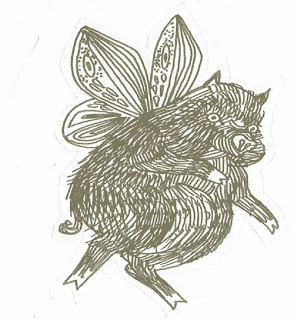
Shown here at a resolution roughly one thousand times its normal size, The Pig Fairy is the size of the fingernail on an adult pinkie finger. Neither a pig nor a fairy, this unbelievably strange winged creature is actually a moth.
Unique to the higher elevations in Britain's Lake District, the Pig Fairy normally lies virtually dormant as a caterpillar that feeds on minerals and nutrients beneath the soil. Once every 148 years, during an event that scientists now call "The Swarm of the Pig Fairies", pig fairy caterpillars all over the region transform into hundreds of thousands of moths that lay eggs in the soil and then fly off into the moonlit sky, eventually drowning themselves in the waters of the Ullswater.
(Additionally, some scientists are now speculating that the Cottingley Fairies, long thought to be a hoax that fooled author Arthur Conan Doyle and others, might also have been a kind of rare "fairy" moth. Some experts believe that the girls didn't fake these photos so much as "enhance" them by superimposing extreme close-ups of heretofore undiscovered fairy moths onto ordinary photos.)
Pig Fairies were definitively discovered during a Pig Fairy Swarm in 1944. While no photographs were taken because of the war time black-out, several of the creatures were captured before they could hurl themselves into the water. The two preserved Pig Fairies are now a part of the permanent collection at the British Museum. It is estimated that the next Swarm will take place during the year 2092, during which scientists hope to learn more about this elusive and mysterious creature.
While it is rare for a caterpillar to transform into a Pig Fairy Moth outside of a Swarm, it does occasionally happen, which accounts for the occasional strange stories and tales. For untold centuries, residents of Cumberland dismissed the occasional sightings as hallucinations and wild stories designed to scare children. While tiny, the moths still appear to the naked eye as a flying pig. In fact, etymologists believe that the phrase "when pigs fly" is an ancient reference to the infrequency of "The Swarm of the Pig Fairies".
Fairy references in literature and art are way too numerous to catalog here, although Pig Fairy references are rarer. One is worth mentioning, especially with respect to the Romantic movement in poetry. Samuel Taylor Coleridge was 24 years old during the Pig Fairy Swarm of 1796, and the experience was so moving and terrifying that he became addicted to opium in an attempt to purge it from his memory. His ongoing obsession with the supernatural and the dark side of nature is now believed to be a direct result of this experience. In fact, the first draft of the Rhyme of the Ancient Mariner was about a river barge captain killing a lone Pig Fairy. It was only after conversations with poet William Wordsworth, a fellow resident of the Lake District who had been away in Italy during the Pig Swarm, that he changed the creature to an albatross and used Captain Cook's then recent voyage of discovery as inspiration.
No comments:
Post a Comment